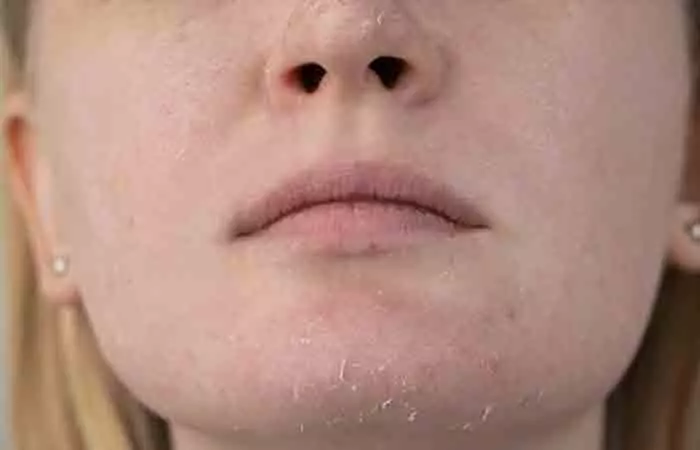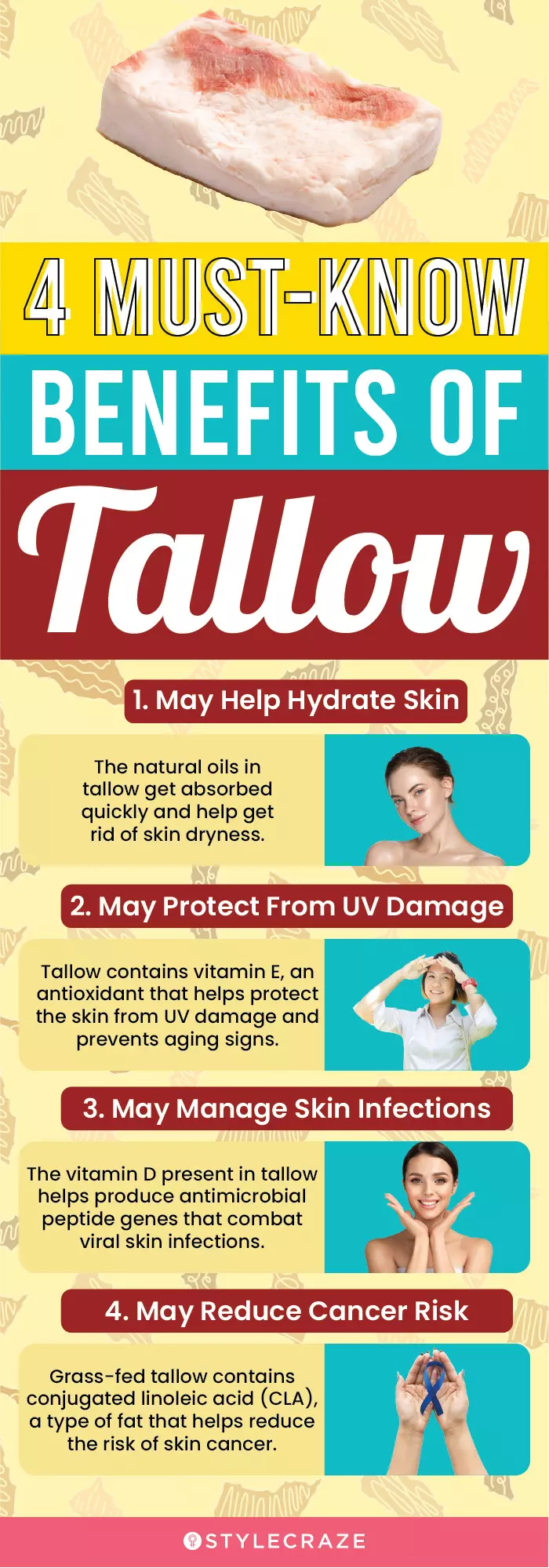If you are not aware of the skin benefits of tallow, you have come to the right place. This article will help you know more about tallow, its nutritional profile, skin benefits, and potential side effects. Scroll down.
What Is Tallow?
Tallow is extracted fat, mainly beef fat. Raw fat is rendered to tallow by melting it. Tallow from 100% grass-fed beef has the most beneficial nutrients. It is composed of stearic acid (1). It is solid at room temperature but takes on an oily consistency after going through the cosmetic production processes. Tallow can be preserved for long periods without refrigeration if maintained in a sealed container. Who Can Use It? Tallow is well tolerated by most skin types due to its similar composition to human sebum How Often? Tallow can be used as often as needed as a daily moisturizer. Caution Individuals with beef allergies or sensitivities should avoid using it.
Mutton Tallow Vs. Beef Tallow
Mutton tallow is derived from sheep whereas beef tallow is derived from beef. Both components are natural, shelf-stable goods. Though both are abundant in saturated fats, beef tallow is higher on the same. Mutton tallow, on the other hand, seems to have more vitamin E than beef tallow. Tallow is most famous for its high oleic, palmitic, and stearic acid content. Beef tallow has more palmitic acid, while mutton tallow has more oleic and stearic acids. Tallow contains the following fatty acids and nutrients:
- Stearic And Oleic Acids (Omega-9): These are present in the skin’s protective outer layer and sebum. These help moisturize and soften the skin. They also have anti-inflammatory properties. Stearic acid also helps heal skin damage by improving its suppleness and elasticity. Oleic acid aids the penetration of the other active ingredients into the skin (2). However, some research suggests that oleic acid may also disrupt skin barrier function (2).
- CLA (Conjugated Linolenic Acid): CLA has anti-inflammatory and antibacterial properties and may help treat various skin disorders. It may also help reduce wrinkles (3).
- Palmitoleic Acid (Omega-7): Palmitoleic acid is another critical component of our skin. It has potent anti-inflammatory properties that promote wound healing (4).
- Palmitic Acid: This acid protects the skin’s lipid barrieri A layer of lipids, fatty acids, and ceramides on the outer layer of the skin that helps protect the skin from damage and dehydration. (5). It also makes the skin smoother.
- Alpha-Linolenic (Omega-3) And Linoleic (Omega-6) Acids: These are optimally balanced in a nearly 1:1 ratio. These essential fatty acids contribute to the skin’s structural integrity and barrier function. They also may influence any inflammatory and immunological responsesi The mechanism by which the body defends itself against substances it deems harmful, protecting it from infectious diseases. . These acids are also found to lighten skin pigmentation induced by UV radiation (6).
- Vitamins:
Vitamin A: It helps develop protein, elastic, and healthy skin cells. It also strengthens skin tissue and makes it firm and youthful. It also supports the daily replacement of skin cells (7). Vitamin D: It helps repair skin and protects skin from free radicals. It also may have photoprotective effectsi Occurring as a result of photoprotection, a biochemical process that helps prevent damage from harmful UV rays of the sun. (8) Vitamin K: It helps improve skin tone and texture. It also may accelerate wound healing (9). Vitamin E: It repairs skin and reverses free radical damagei Molecules that form when cells undergo chemical changes, which can cause collagen to breakdown and lead to premature aging. (10). It also maymoisturize skin
This composition of tallow offers multiple skin benefits. We discuss them in the following section. Read on to know more about this organic skin care ingredient.
What Are The Benefits Of Tallow For Skin?
- May Help Treat Dry Skin The natural oils in tallow may help hydrate skin. They get absorbed quickly and reduce cellular dryness. They do not clog pores or make skin greasy. Tallow, being a natural skin care ingredient, is suitable for both dry and oily skin types. However, research is limited in this regard. Jennifer, a blogger, recounts her recent experiment of making tallow bath products – body butter and hand/foot balm. She shares two recipes of body butter that contain different percentages of tallow: recipe 1 with 25% and recipe 2 with 40%. She writes, “I loved recipe 2 as a heavy duty face moisturizer. It kept my dry, flaky skin nice, and if I put it in at night by morning, it was absorbed in, and I could put makeup on and get through the day without my skin flaking (i).” Tallow’s effects last long, and it doesn’t have to be applied more than once a day.
- May Make Skin Looking Younger The vitamin E in tallow is very beneficial for aging skin. Its antioxidant properties protect the skin from UV exposure and reduce the associated damage (10). Tallow also fights free radical damage and may reduce the formation of fine lines and wrinkles. It also may make skin very soft with daily use. Vitamin E has also been proven to protect collagen from breaking down (10).
- May Be Good For Acne-Prone Skin Tallow’s antibacterial, anti-inflammatory, and skin-repairing characteristics make it ideal for acne-prone skin. However, concrete research is lacking in this regard.
- May Fight Skin Infections The vitamin D in tallow may promote the production of anti-microbial peptide genes that helps fight viral skin infections (11). Grass-fed tallow contains CLA. CLA appears to have anti-cancer characteristics and may help reduce the risk of skin tumors (12).
- May Be Compatible With Human Skin Cell Biology Tallow may be compatible with our cells’ biochemistry. Tallow used for skin care has a saturated fat ratio of 50-55%, making it potentially more suitable for human skin. These are the few important benefits of tallow. There are several tallow skin care products available out there that you can add to your care routine. Try using tallow soap instead of a commercial one. You can also use a tallow moisturizer to improve skin texture and suppleness. But you also must be aware of its side effects before you start to use it. Check out the following section that discusses how tallow can be beneficial for eczema.
Tallow For Eczema: Does It Help?
Tallow is believed to have potential benefits for eczema-prone skin. Its high concentration of fatty acids, including conjugated linoleic acid (CLA) and palmitoleic acid, makes it deeply moisturizing and nourishing for dry and irritated skin. Tallow is rich in vitamins A, D, E, and K, which are known to support skin health and help alleviate inflammation. Additionally, tallow’s anti-inflammatory properties may aid in reducing redness and soothing itchiness associated with eczema, as observed in a study involving rats and a treatment that made use of tallow and other ingredients (13). However, it is best to seek professional advice before using tallow for eczema as some people can be allergic to animal products or might experience a reaction. Tallow comes with its fair share of downsides, read on to know what they are.
Using Tallow On Your Skin: Precautions And Side Effects
Impurity Issues
The purity of animal parts which tallow is extracted from is an important consideration. The diet of such animals also plays a role in tallow purity. It is quite a challenge to know unless you are procuring tallow from an FDA-approved product.
Not Cruelty-Free
Tallow is animal fat and is extracted from a dead animal. This can be off-putting for animal lovers. The demand for cruelty-free cosmetics is increasing, for ethical and environmental reasons.
Unpleasant Odor
Though the fat itself has no odor, but part of the animal’s muscle and other tissue might enter the skin are mix during processing. This may make the finished product smell awful.
Stability Issues
Tallow is not stable. It goes through many production procedures, including heating, before it is made available as a finished product. Hence, such products like a tallow cream or tallow lotion may lack consistency in color, appearance, and odor. Is tallow good for lips? Yes, it is good for lips as it helps moisturize lips and makes them soft and supple. Is tallow good for hair? Tallow is good for hair. The anti-inflammatory and antibacterial properties of tallow may help heal the scalp and reduce dandruff. Can tallow be used as a sunscreen? Tallow contains vitamin E which helps to shield the skin from UV exposure and reduces potential skin damage (10). However, there is no scientific evidence that states that tallow can be a substitute for sunscreen. Further, it may not be a good idea to use it in place of sunscreen as it might be impure, since it’s directly extracted from dead animal fat.
Illustration: Tallow For Skin – What It Is Benefits And How To Use It
Witness the transformative power of tallow for skin care in this captivating video. Experience the before and after results and learn how to incorporate tallow in your routine for healthier, radiant skin.












